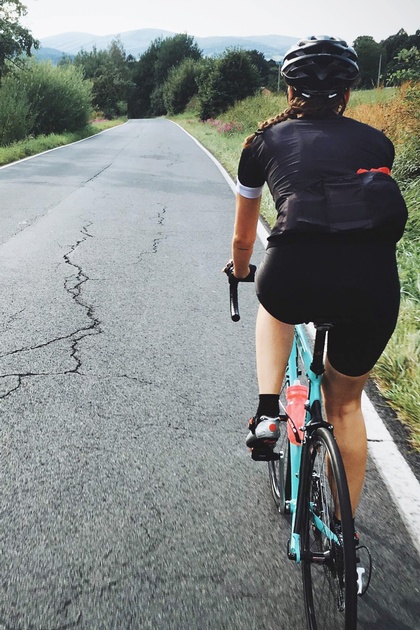
Posture on the bike...
Foto: iStock.com/Tomas Hliva
Cycling for hours puts an immense strain on the body. Find out here which cycling posture helps and what you need to watch out for.
This article is presented by Spiraldynamik
The human body is not built to sit on a bike for hours. While your cycling posture can certainly be improved, it is never perfect. The more you cycle, the more important the correct position.
But which cycling posture is correct? Let's start from the beginning:
Wrists straight
The wrists carry part of your body weight while cycling. A functionally correct posture when leaning on the handlebars is crucial for the wrists. The hand is an extension of the forearm, so the middle finger should be in line with your forearm. The back of your hand should be slightly raised. Unfortunately, this grip position is not possible in all places on the handlebars. When gripping the top bar, the correct hand position is easy to implement; this is a bit more difficult when gripping the hoods. The wrist can quickly become overloaded here by kinking towards the little finger. If you want to cycle in an aerodynamic position, grip the lower bar. But your hands must be well positioned here too. Changing your hand position on the handlebars will also help you put less strain on your wrists.
Elbows bent
Your elbows should always be slightly bent. Even though this requires more energy, it pays off. When your elbow is in the stretched position, the elbow joint will sooner or later suffer too many impacts, which could damage it. You can practice bending your elbows slightly in the quadruped or push-up position.
Shoulders down
Keep your shoulders away from your ears so your neck muscles can remain relaxed. Roll your shoulders backwards and down. The longer the bike trip, the more tension there is in the shoulder and neck area. Aim to «loosen» your shoulders while cycling whenever you can. You can also practice this in the quadruped or push-up position.
Neck long
Your neck should be as long and elongated as possible. This means curling your chin slightly towards your breastbone and pulling the back of your head up. But on the bike you also have to look ahead. Looking ahead creates a kink in the neck, which can quickly become painful. Here you need a compromise between a good posture and a forward view. Whenever it is possible and safe to do so, keep looking down while elongating your neck. This creates relaxation in the muscles and neck joints.
Thoracic spine stretched
Unfortunately, your thoracic spine can curve more and more over time to give you a stooped posture, which puts your neck under more stress again. The straighter your thoracic spine, the easier the posture for your neck. Lift your sternum forwards and up as much as possible. This will prevent you from kinking your neck. Even if this movement tires you quickly, correct yourself again and again to maintain the desired position.
Incorporate change
During your bike trip, it's important to keep changing your cycling posture. The longer you hold a position, the greater the stress on your body.
This quickly leads to pain. Every time you change position, you give your muscles and joints a little breather. Every time you change your grip position, you relieve your wrists, elbows and shoulders for a short time. If changing position doesn't bring the relief you're hoping for, compensatory exercises alongside cycling are a must. Even if you want to be aerodynamically perfect and can only rarely leave this position, it is vital to give your body a second mobility training unit. You can find out more details about compensatory training for your cycling posture in my next article.
This may be of interest for you too


